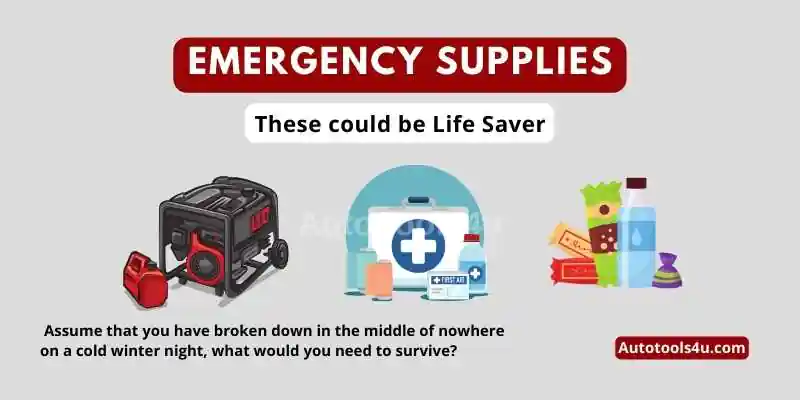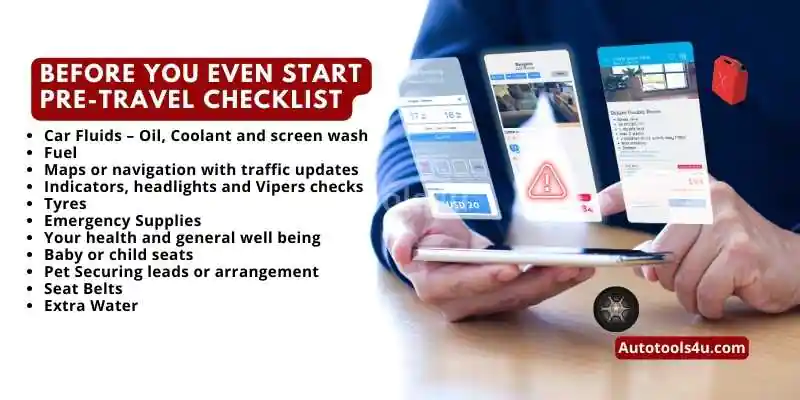Weather is a changing phenomenon, and with the greenhouse gases crisis flaring up, weather patterns are getting more and more unpredictable. Basically, we are going through a massive change in the overall climate of our planet and these weather patterns are just the tip of the iceberg of the drastic permanent changes to come.
While driving, it’s all too common these days to come across unexpected adverse weather conditions and sometimes we are not prepared for it fully. We shall now discuss some of the tips and techniques that can be useful while you are driving in bad weather or have broken down.
1.1 Before you Even Start – Pre-travel Checklist
You should be making a quick check before setting off, this is generally true, more so on bad weather days.
- Car Fluids – Oil, Coolant and screen wash
- Fuel
- Maps or navigation with traffic updates
- Indicators, headlights and Vipers checks
- Tyres
- Emergency Supplies
- Your health and general well being
- Baby or child seats
- Pet Securing leads or arrangement if required
- Seat Belts
- Extra Water
1.2 Planning- Check Conditions and Updates
We have discussed this before in some of the other blogs that planning is important anyway when you are driving from point A to point B, in bad weather conditions it becomes imperative that you check the weather and traffic updates on your route and pick up the best route possible. Google maps will show the congestion of routes and if you are travelling further check the met office website for weather updates.
A few minutes spent on this vital exercise can be so much value-adding that it may make all the difference in the journey.
1.3 Due Care – Drive According to Conditions
Adapt your driving style to changing weather conditions. For example on a rainy and wet day, increase the gap between your car and the can in front. Be extra vigilant on the bendy roads, allowing for more time, especially on the scenic but tricky country roads. Try to stick to the main route as much as possible even if your navigation sends you to an unknown side road. This is where your homework on route and planning will pay off as you will know it well or at least be more familiar with the road network to your destination. If it’s bad weather, and showing no signs of respite, pull up somewhere safe and check weather updates and road conditions before moving again.

1.4 Driving in the snow – What Can we do?
If possible, cancel all your travel plans for snowy weather, enjoy the whites at home. If not, stick to the main A road and avoid the side Broads. Main Roads are more likely to be treated with grit and more likely to be operational during snowy periods. Be extra careful on slip roads and slopes and heights as these pose serious challenges for traction control during snowfall periods. Most cars that break down during snowy seasons are on hills and/or slopes because that’s where they are most likely to lose control.
Slow down your speed as much as possible. Do not hit the brakes hard it will send your car into skid motion if traction control is struggling with the amount of snow. Use slightly deflated tyres if possible to get more surface area on road.
Make sure that you are visible to other road users. Turn on headlights/fog lights. If broken down never forget to activate hazard lights. Keep distance maximum between next car on road. Use the highest gear possible while driving at slower speeds, this will help stop spinning tyres which can lead to traction and control failure. If you do skid do not panic and do not press hard on brakes, it will make the skid worst. Steer into the skid, meaning If your car backend is skidding towards the left, steer towards the left to counter the skid.
1.5 Driving in Wet Condition – Rain and Surface Water
As generally applies, keep a more than safe stopping distance from the car in front. Slow down to a comfortable speed to be able to respond to events with more time in hand. If in case your car does hydroplanes, take your foot off the gas and do not brake.
Passing through flood water could be a very tricky undertaking. How do you safely tell the depth of water? it is a place you know very well then you may take chances however on unknown roads and especially passing through shallows or fords, watch out for signs for any information. Do not underestimate the power of floods, if not sure, you are far better off just stopping and waiting for things to calm down. There have been instances in the UK that individuals have washed away with cars in ordinary shallow water crossing during floods, which would otherwise be harmless.

1.6 Driving in Fog – Visibility is a key issue
In foggy conditions, your visibility can drastically be impacted so much so down to 20 feet!
Slow right down if you cannot see far enough. Resist the temptation to turn on full beam lights, it won’t help but it will distract and dazzle oncoming drivers.
1.7 Driving in Windy Conditions – Check the Traffic updates
As applies in general, check traffic updates and highway traffic information. Some roads will close down fully during high winds which will force you to go onto unfamiliar roads. Check the motorway matrix display and information on traffic updates.
On open stretches of road in high winds, beware of Tall or high sided vehicles. These are the ones that are suspectable to windy conditions and may topple over very quick and crush anyone besides them.
One major hazard is trees overlooking or very close to roads. There are always fatalities every year due to falling trees on vehicles, especially in windy conditions. Any tree which is nearing its life cycle and/or sick or infected is more likely to fall during forceful winds. While we cannot predict tree falls but nevertheless we can be a bit more careful when passing through or completely avoiding risky roads.

1.8 Emergency Supplies – These could be Life Saver
We have discussed this in other blogs as well. Assume that you have broken down in the middle of nowhere on a cold winter night, what would you need to survive? Make a list of things including
- Torch
- Flashlights
- High Vis Warm coat
- Some Biscuits etc
- Some Drinks
- Warm boots and Socks
- A Blanket if possible
- Some emergency medicine such paracetamol, disinfectant and dressings/plasters.
- Wet Wipes and/or Kitchen towels
Epilogue
Autoinsurancezx is a new shining star on the front of auto care, information, and development that is updated with the latest industry trends and ideas. we have a collection of articles on varied topics, anything from car wash tips to maintaining your brand new Tesla. keep us bookmarked on your devices and check for new articles and information which would help you in routine car maintenance as well as following up on the latest industry trends.


4 thoughts on “Safe Driving – How to Drive in Cold and Wet Conditions”